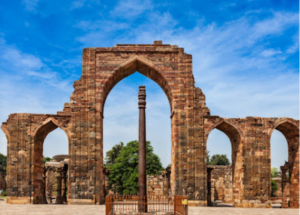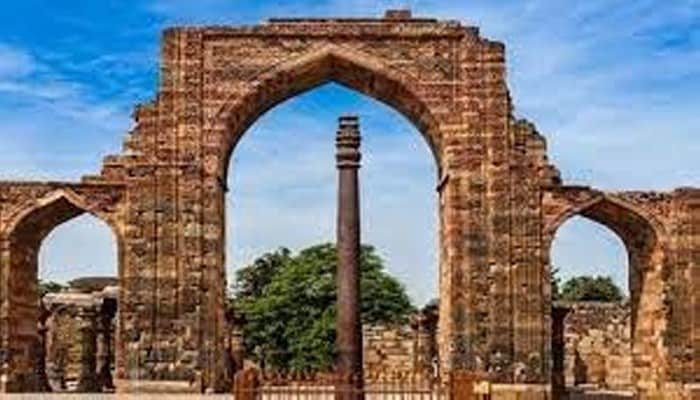The Iron Pillar at the Qutub Complex of South Delhi has intrigued people worldwide. Numerous scientists, archaeologists, historians and metallurgists have combined their minds to understand the mystery. But what is this mystery? It is time to find out.
Key Facts
| Days Open | All days of the week. |
| Timings | 6:00 a.m. – 6:00 p.m. |
| Entry Fee | Indians- ₹10; Foreigners- ₹250 |
| Nearest Metro Station | Qutub Minar Metro Station on the Yellow Line |
What is the mystery of the Iron Pillar in Delhi?
This pillar is approximately 1600 years old, and the Iron on its surface has not rusted! Some people believe that the pillar possesses spiritual powers that do not make it rust. Meanwhile, after extensive research, scientists and historians may have found an explanation behind this phenomenon.
The mystery lies in the composition of the Iron used to make the pillar. Experts believe the forgers’ skills and craftsmanship back in the day make the pillar last even to date.

Chemical Composition – Why Is It Not Rusted?
Some theories state that since this Iron Pillar has a high content of Phosphorus and complete non-existence of Sulphur or Magnesium, it prevents the pillar from rusting. Environmental research also reveals that the pillar was made to withstand a relative humidity of about 70%, despite experiencing four seasons in a year.
Others also state that the slag surface coating used in this Pillar after being forged and the application of clarified butter coating during its usage may have also resisted the rust from appearing.
Another research recently discovered that the Iron Pillar has a thin covering of a compound named ‘Misawite.’ This compound is made from a perfect amalgamation of Iron, hydrogen, and oxygen, consistently protecting the pillar from rusting. This thin film of the compound came into existence due to the natural catalysis of a very high amount of Phosphorus. This catalysis occurred just three years after its establishment, and since then, the layer has increased in thickness by 1/20th of a millimetre after 1600 years.
Process of making the Iron
In ancient times, the extraction and processing of Iron were done with precision and the highest quality of wrought Iron was used, thanks to the abundance of metals available. A unique technique used during the iron-making process in those ancient years was the application of a high content of phosphorus. The process involved mixing the core of the Iron with charcoal, and the slag iron particles were reduced to steel in just one step.
Today, ironsmiths use limestone instead of charcoal to mould Iron into steel. Unfortunately, this results in the loss of phosphorus by most of the slag iron particles during the iron-making process. As a result, most iron products today rust at the mere touch of humidity or a change in climatic conditions.
History
The pillar is located in the courtyard of the Quwwat-ul-Islam Mosque in Delhi, India, and stands at a height of around 23 feet. It was initially erected in the early 4th century CE by Chandragupta II, a powerful ruler of the Gupta Empire, and is believed to have been initially installed in a Vishnu temple at Udaygiri, Madhya Pradesh, in central India but was later transported to Delhi and re-erected at its current location by Sultan Iltutmish in 1233 AD
Architecture

This Iron Pillar is a testament to the ancient art of metallurgy and the skilled techniques required to forge such a remarkable masterpiece. Here are some architectural facts about this place:
- Weighing 6 tonnes and standing 7.21 meters tall, it has a beautifully carved base measuring 48 cm in diameter.
- The pillar tapers to about 29 cm at the tip, with an ornate bell weighing 646 kilos and the rest of the pillar weighing 5865 kilos.
- The decorative top of the pillar has a deep socket that was probably meant to hold the statue of Lord Garuda or the ‘Sun Bird,’ a significant feature seen on many pillars like this one.
It is one of the most impressive structures to have existed through the centuries, withstanding the corrosion of time and piquing the curiosity of all who see it.
Inscriptions on the Iron Pillar
King Chandragupta II of the Gupta dynasty has his victories inscribed on the pillar. He was a Bhagavata, meaning “follower of Lord Vishnu.” So, the inscription identifies the king as a follower of the Hindu deity Vishnu and records the construction of a Vishnu Dhwaja (also known as a pillar) on a hill known as Vishnupada, which is also known as the “hill of the footprint of Vishnu.”
The Pillar’s Significance in the Present
Today, the Iron Pillar is a popular spot for tourists and visitors to test their loyalty and trustworthiness. Many people wrap their arms around the pillar, trying to make their fingers touch each other to prove their truthfulness and fidelity to their loved ones. This act is viewed with intense delight and has become one of the main reasons for the pillar’s popularity.
- Is Delhi metro free for ladies? - November 27, 2022
- Is Delhi Metro profitable? - November 27, 2022
- List of biggest hospitals in Delhi - November 25, 2022

